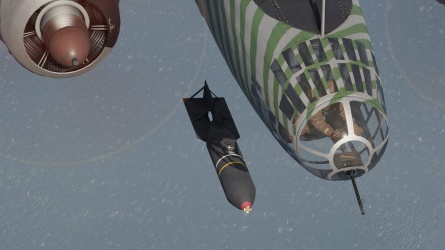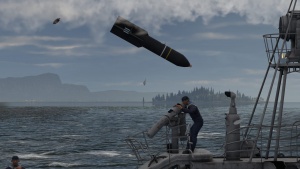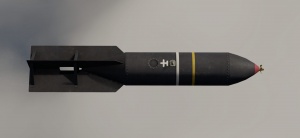Difference between revisions of "Army Type 92 GPHE (500 kg)"
Colok76286 (talk | contribs) (Added About template) |
Jareel_Skaj (talk | contribs) (Filled the article with content.) |
||
| Line 4: | Line 4: | ||
| link = Type 92 (Disambiguation) | | link = Type 92 (Disambiguation) | ||
}} | }} | ||
| + | [[File:Army Type 92 GPHE (500 kg) from Ki-49-IIa.jpg|thumb|x250px|The '''{{PAGENAME}}''' dropped from {{Specs-Link|ki-49_2a}}.]] | ||
== Description == | == Description == | ||
| − | ''Write an introduction to the article in 2-3 small paragraphs. Briefly tell us about the history of the development and combat using the weaponry and also about its features. Compile a list of air, ground, or naval vehicles that feature this weapon system in the game.'' | + | <!-- ''Write an introduction to the article in 2-3 small paragraphs. Briefly tell us about the history of the development and combat using the weaponry and also about its features. Compile a list of air, ground, or naval vehicles that feature this weapon system in the game.'' --> |
| + | '''{{PAGENAME}}''' was a bomb used by the aviation of the Imperial Japanese Army during the World War Two, primarily on its frontline bombers. It's a very competent explosive, able to deal with tanks and naval vessels alike. | ||
=== Vehicles equipped with this weapon === | === Vehicles equipped with this weapon === | ||
| Line 20: | Line 22: | ||
== General info == | == General info == | ||
| − | ''Tell us about the tactical and technical characteristics of the bomb.'' | + | <!-- ''Tell us about the tactical and technical characteristics of the bomb.'' --> |
| + | {| class="wikitable" style="text-align:center" | ||
| + | ! colspan="2" | Bomb characteristics | ||
| + | |- | ||
| + | | '''Mass''' || 500 kg | ||
| + | |- | ||
| + | | '''Explosive mass''' || 223 kg | ||
| + | |- | ||
| + | | '''Explosive type''' || Shimose | ||
| + | |- | ||
| + | | '''TNT equivalent''' || 245.3 kg | ||
| + | |- | ||
| + | | '''HE max penetration''' || 92 mm | ||
| + | |- | ||
| + | | '''Armour destruction radius''' || 10 m | ||
| + | |- | ||
| + | | '''Fragment dispersion radius''' || 139 m | ||
| + | |- | ||
| + | |} | ||
=== Effective damage === | === Effective damage === | ||
| − | ''Describe the type of damage produced by this type of bomb (high explosive, splash damage, etc)'' | + | <!-- ''Describe the type of damage produced by this type of bomb (high explosive, splash damage, etc)'' --> |
| + | The bomb produces high explosive damage, able to [[Damage mechanics#Overpressure|overpressure]] soft-body vehicles from even a relatively distant explosion. Dealing with harder targets, such as tanks, or fully armoured tank destroyers, requires the bomb to land within less than 10 meters from the target. Against blue water naval vessels, either a direct hit is required, or dropping the bomb ahead of the vessel, so that it'd explode under the keel while sinking to maximise the damage output. | ||
=== Comparison with analogues === | === Comparison with analogues === | ||
| − | ''Give a comparative description of bombs that have firepower equal to this weapon.'' | + | <!-- ''Give a comparative description of bombs that have firepower equal to this weapon.'' --> |
| + | Type 92 can be considered an iconic 500 kg bomb, featuring a spot-on 500 kg mass and average explosive filler. Compared to its [[Navy Type Number 50 Model 2 (500 kg)|naval equivalent]], it boasts a slightly larger explosive filler, but the difference is unlikely to be palatable in a real combat. | ||
| + | {{#vardefine:lb2kg|0.45359237}} | ||
| + | {| class="wikitable sortable" style="text-align:center" | ||
| + | |- | ||
| + | ! colspan="3" | Bomb | ||
| + | ! style="width:30%" | Mass<br>(kg) | ||
| + | ! style="width:30%" | TNT equivalent<br>(kg) | ||
| + | |- style="height: 100%;" | ||
| + | | [[File:USA flag.png|link=|25px]] | ||
| + | | [[File:Bombs large.png|link=|x25px]][[File:Bombs heavy middle.png|link=|x25px]] | ||
| + | | [[AN-M65A1 (1,000 lb)|1,000 lb AN-M65A1]] | ||
| + | | {{#expr: 1104*{{#var:lb2kg}} round 0}} | ||
| + | | 318.48 | ||
| + | |- style="height: 100%;" | ||
| + | | [[File:USA flag.png|link=|25px]] | ||
| + | | [[File:Bombs special.png|link=|x25px]] | ||
| + | | [[LDGP Mk 83 (1,000 lb)|1,000 lb LDGP Mk 83]] | ||
| + | | {{#expr: 985*{{#var:lb2kg}} round 0}} | ||
| + | | 272.43 | ||
| + | |- style="height: 100%;" | ||
| + | | [[File:Germany flag.png|link=|25px]] | ||
| + | | [[File:Bombs large.png|link=|x25px]][[File:Bombs special.png|link=|x25px]] | ||
| + | | [[SC500K (500 kg)]] | ||
| + | | 500 | ||
| + | | 260 | ||
| + | |- style="height: 100%;" | ||
| + | | [[File:USSR flag.png|link=|25px]] | ||
| + | | [[File:Bombs large.png|link=|x25px]] | ||
| + | | [[FAB-500sv (500 kg)]] | ||
| + | | 508.3 | ||
| + | | 325 | ||
| + | |- style="height: 100%;" | ||
| + | | [[File:USSR flag.png|link=|25px]] | ||
| + | | [[File:Bombs special.png|link=|x25px]] | ||
| + | | [[FAB-500M-43 (500 kg)]] | ||
| + | | 468.57 | ||
| + | | 243.71 | ||
| + | |- style="height: 100%;" | ||
| + | | [[File:USSR flag.png|link=|25px]] | ||
| + | | [[File:Bombs heavy.png|link=|x25px]] | ||
| + | | [[FAB-500M-44 (500 kg)]] | ||
| + | | 477.1 | ||
| + | | 222.15 | ||
| + | |- style="height: 100%;" | ||
| + | | [[File:Britain flag.png|link=|25px]] | ||
| + | | [[File:Bombs large.png|link=|x25px]] | ||
| + | | [[M.C. Mk.I (1,000 lb)|M.C. 1,000 lb Mk.I]] | ||
| + | | {{#expr: 1021*{{#var:lb2kg}} round 0}} | ||
| + | | 215.4 | ||
| + | |- style="height: 100%;" | ||
| + | | [[File:Japan flag.png|link=|25px]] | ||
| + | | [[File:Bombs heavy middle.png|link=|x25px]] | ||
| + | | [[Army Type 92 GPHE (500 kg)|500 kg Type 92 GPHE]] | ||
| + | | 500 | ||
| + | | 245.3 | ||
| + | |- style="height: 100%;" | ||
| + | | [[File:Japan flag.png|link=|25px]] | ||
| + | | [[File:Bombs heavy middle.png|link=|x25px]] | ||
| + | | [[Navy Type Number 50 Model 2 (500 kg)|Navy Type Number 50 Model 2]] | ||
| + | | 500 | ||
| + | | 227.5 | ||
| + | |- style="height: 100%;" | ||
| + | | [[File:Italy flag.png|link=|25px]] | ||
| + | | [[File:Bombs special.png|link=|x25px]] | ||
| + | | [[GP 500 (500 kg)]] | ||
| + | | 508 | ||
| + | | 216 | ||
| + | |- style="height: 100%;" | ||
| + | | [[File:France flag.png|link=|25px]] | ||
| + | | [[File:Bombs special.png|link=|x25px]] | ||
| + | | [[No.2 (500 kg)|500 kg No.2]] | ||
| + | | 520 | ||
| + | | 255.68 | ||
| + | |- style="height: 100%;" | ||
| + | | [[File:France flag.png|link=|25px]][[File:Netherlands flag.png|link=|25px]] | ||
| + | | [[File:Bombs heavy middle.png|link=|x25px]] | ||
| + | | [[Vliegtuigbom (400 kg)|400 kg Vliegtuigbom]] | ||
| + | | 400 | ||
| + | | 167 | ||
| + | |- | ||
| + | |} | ||
== Usage in battles == | == Usage in battles == | ||
| − | 'Describe situations when you would utilize this bomb in game (vehicle, pillbox, base, etc.)'' | + | <!-- ''Describe situations when you would utilize this bomb in game (vehicle, pillbox, base, etc.)'' --> |
| + | [[File:Army Type 92 GPHE (500 kg) size comparsion.jpg|thumb|Size comparison of the Army Type 92 GPHE to a sailor]] | ||
| + | Typically, for a 500 kg bombs, it features a nice compromise between the mass of the bomb and its destructive capability. It's able to knock out tanks from near-misses and heavily cripple, if not outright destroy, frigates and destroyers. | ||
=== Pros and cons === | === Pros and cons === | ||
| − | ''Summarise and briefly evaluate the weaponry in terms of its characteristics and combat effectiveness. Mark pros and cons as a list.'' | + | <!-- ''Summarise and briefly evaluate the weaponry in terms of its characteristics and combat effectiveness. Mark pros and cons as a list.'' --> |
'''Pros:''' | '''Pros:''' | ||
| − | * | + | * Good TNT equivalent of the explosive filler |
'''Cons:''' | '''Cons:''' | ||
| − | * | + | * Available only on bombers. No option to use it on strike craft or fighters. |
== History == | == History == | ||
| − | ''Examine the history of the creation and combat usage of the weapon in more detail than in the introduction. If the historical reference turns out to be too long, take it to a separate article, taking a link to the article about the weapon and adding a block "/ History" (example: <nowiki>https://wiki.warthunder.com/(Weapon-name)/History</nowiki>) and add a link to it here using the <code>main</code> template. Be sure to reference text and sources by using <code><nowiki><ref></ref></nowiki></code>, as well as adding them at the end of the article with <code><nowiki><references /></nowiki></code>.'' | + | <!-- ''Examine the history of the creation and combat usage of the weapon in more detail than in the introduction. If the historical reference turns out to be too long, take it to a separate article, taking a link to the article about the weapon and adding a block "/ History" (example: <nowiki>https://wiki.warthunder.com/(Weapon-name)/History</nowiki>) and add a link to it here using the <code>main</code> template. Be sure to reference text and sources by using <code><nowiki><ref></ref></nowiki></code>, as well as adding them at the end of the article with <code><nowiki><references /></nowiki></code>.'' --> |
| + | [[File:Army Type 92 GPHE (500 kg).jpg|thumb|Details of the {{PAGENAME}}]] | ||
| + | Type 92 High-Explosive bomb was used by the Imperial Japanese Army during the World War Two. It had a black steel body with a cast red-tipped nose cone. The body had two bands: one yellow and one white, ahead of the suspension lug. Filling was made of pre-formed paper-wrapped [[wikipedia:Picric acid|Picric acid]] blocks, consisting a total of 46.4% of the body mass of the bomb. It used a nose-mounted fuse, either ''Type 92 Tail Fuze For Large Bombs B-4 (a)'', which fused instantly on impact or ''Type 92 Nose Fuze For Large Bombs A-4 (a)'', which used almost instantly as well, but had a more complex design. | ||
| + | |||
| + | These bombs were used primarily against ground targets - IJA used Type 4 bombs against naval surface vessels. | ||
== Media == | == Media == | ||
| Line 61: | Line 169: | ||
* [http://ww2data.blogspot.com/2015/12/imperial-japanese-army-explosives-bombs.html <nowiki>[WW2 Data Blog]</nowiki> Imperial Japanese Army Explosives - Bombs (Part 1)] | * [http://ww2data.blogspot.com/2015/12/imperial-japanese-army-explosives-bombs.html <nowiki>[WW2 Data Blog]</nowiki> Imperial Japanese Army Explosives - Bombs (Part 1)] | ||
| + | * [https://www.bulletpicker.com/pdf/TM-9-1985-4.pdf <nowiki>[Bulletpicker]</nowiki> TM 9-1985-4/TO 39B-1A-11 JAPANESE EXPLOSIVE ORDNANCE], page 9 | ||
{{Bombs}} | {{Bombs}} | ||
[[Category:Suspended armaments]] | [[Category:Suspended armaments]] | ||
Latest revision as of 21:41, 7 August 2024
| This page is about the Japanese bomb Army Type 92 GPHE (500 kg). For other uses, see Type 92 (Disambiguation). |

Contents
Description
Army Type 92 GPHE (500 kg) was a bomb used by the aviation of the Imperial Japanese Army during the World War Two, primarily on its frontline bombers. It's a very competent explosive, able to deal with tanks and naval vessels alike.
Vehicles equipped with this weapon
General info
| Bomb characteristics | |
|---|---|
| Mass | 500 kg |
| Explosive mass | 223 kg |
| Explosive type | Shimose |
| TNT equivalent | 245.3 kg |
| HE max penetration | 92 mm |
| Armour destruction radius | 10 m |
| Fragment dispersion radius | 139 m |
Effective damage
The bomb produces high explosive damage, able to overpressure soft-body vehicles from even a relatively distant explosion. Dealing with harder targets, such as tanks, or fully armoured tank destroyers, requires the bomb to land within less than 10 meters from the target. Against blue water naval vessels, either a direct hit is required, or dropping the bomb ahead of the vessel, so that it'd explode under the keel while sinking to maximise the damage output.
Comparison with analogues
Type 92 can be considered an iconic 500 kg bomb, featuring a spot-on 500 kg mass and average explosive filler. Compared to its naval equivalent, it boasts a slightly larger explosive filler, but the difference is unlikely to be palatable in a real combat.
| Bomb | Mass (kg) |
TNT equivalent (kg) | ||
|---|---|---|---|---|
| |
|
1,000 lb AN-M65A1 | 501 | 318.48 |
| |
|
1,000 lb LDGP Mk 83 | 447 | 272.43 |
| |
|
SC500K (500 kg) | 500 | 260 |
| |
|
FAB-500sv (500 kg) | 508.3 | 325 |
| |
|
FAB-500M-43 (500 kg) | 468.57 | 243.71 |
| |
|
FAB-500M-44 (500 kg) | 477.1 | 222.15 |
| |
|
M.C. 1,000 lb Mk.I | 463 | 215.4 |
| |
|
500 kg Type 92 GPHE | 500 | 245.3 |
| |
|
Navy Type Number 50 Model 2 | 500 | 227.5 |
| |
|
GP 500 (500 kg) | 508 | 216 |
| |
|
500 kg No.2 | 520 | 255.68 |
| |
|
400 kg Vliegtuigbom | 400 | 167 |
Usage in battles
Typically, for a 500 kg bombs, it features a nice compromise between the mass of the bomb and its destructive capability. It's able to knock out tanks from near-misses and heavily cripple, if not outright destroy, frigates and destroyers.
Pros and cons
Pros:
- Good TNT equivalent of the explosive filler
Cons:
- Available only on bombers. No option to use it on strike craft or fighters.
History
Type 92 High-Explosive bomb was used by the Imperial Japanese Army during the World War Two. It had a black steel body with a cast red-tipped nose cone. The body had two bands: one yellow and one white, ahead of the suspension lug. Filling was made of pre-formed paper-wrapped Picric acid blocks, consisting a total of 46.4% of the body mass of the bomb. It used a nose-mounted fuse, either Type 92 Tail Fuze For Large Bombs B-4 (a), which fused instantly on impact or Type 92 Nose Fuze For Large Bombs A-4 (a), which used almost instantly as well, but had a more complex design.
These bombs were used primarily against ground targets - IJA used Type 4 bombs against naval surface vessels.
Media
Excellent additions to the article would be video guides, screenshots from the game, and photos.
See also
External links
- [WW2 Data Blog] Imperial Japanese Army Explosives - Bombs (Part 1)
- [Bulletpicker] TM 9-1985-4/TO 39B-1A-11 JAPANESE EXPLOSIVE ORDNANCE, page 9





